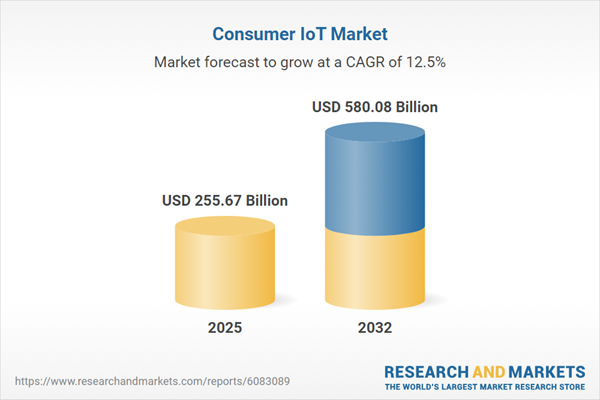Speak directly to the analyst to clarify any post sales queries you may have.
The Consumer IoT Market is characterized by rapid transformation as connectivity technologies converge with advanced analytics, shifting user expectations and competitive positioning for organizations worldwide. Decision-makers are now required to address evolving device ecosystems, regulatory developments and varied adoption patterns to capture value in this sector.
Market Snapshot: Consumer IoT Market Size and Growth Trends
The Consumer IoT Market grew from USD 226.80 billion in 2024 to USD 255.67 billion in 2025. It is projected to advance at a CAGR of 12.45%, reaching USD 580.08 billion by 2032. This expansion is supported by technological advancements in connectivity, AI integration, and the increasing role of smart home systems, wearables and connected vehicles across all major regions.
Scope & Segmentation: Comprehensive Industry Coverage
- Smart Home: Smart door locks, lighting systems, security cameras, speakers (Bluetooth, Thread, Wi-Fi, Zigbee), and thermostats.
- Wearables: AR glasses, fitness trackers, smart clothing, smartwatches (WatchOS, WearOS).
- Connected Cars: Advanced driver assistance systems, infotainment (4G/5G, C-V2X, DSRC), telematics, vehicle-to-everything communication.
- Healthcare Devices: Health wearables (smart patches, rings, smartwatches), remote monitoring, smart medical implants, telehealth kiosks.
- Smart Entertainment: Home gaming consoles, set-top boxes, streaming media players, smart TVs (Android TV, Roku TV, Tizen, WebOS).
- Regional Coverage: Americas (North America: United States, Canada, Mexico; Latin America: Brazil, Argentina, Chile, Colombia, Peru), Europe, Middle East & Africa (United Kingdom, Germany, France, Russia, Italy, Spain, Netherlands, Sweden, Poland, Switzerland, United Arab Emirates, Saudi Arabia, Qatar, Turkey, Israel, South Africa, Nigeria, Egypt, Kenya), Asia-Pacific (China, India, Japan, Australia, South Korea, Indonesia, Thailand, Malaysia, Singapore, Taiwan).
- Leading Companies: Amazon.com, Inc., Apple Inc., Xiaomi Corporation, Alphabet Inc., Samsung Electronics Co., Ltd., Huawei Technologies Co., Ltd., Signify N.V., LG Electronics Inc., Robert Bosch GmbH, Sony Group Corporation.
Key Takeaways for Senior Decision-Makers
- Edge computing and near-device intelligence are redefining IoT solutions, increasing automation and reducing latency for consumer applications.
- Interoperability is now a central competitive factor, with demand for seamless ecosystem integration driving industry standards and open API adoption.
- Heightened focus on security and privacy makes biometric authentication, encryption, and decentralized identity management essential for differentiation.
- Industry alliances, mergers, and acquisitions are shaping market structure, enabling rapid innovation and broadening product capabilities.
- Regulatory shifts and regional policy variations are influencing deployment strategies and compliance investments across key markets.
- Sustainability initiatives are gaining traction, resulting in increased use of energy-efficient components and recyclable designs throughout the value chain.
Tariff Impact: Navigating Regulatory and Cost Structure Shifts
Upcoming tariff adjustments in the United States for 2025 are anticipated to disrupt consumer IoT supply chains. Increased duties on components such as semiconductors and sensors will likely prompt firms to reevaluate sourcing. Some organizations are already diversifying manufacturing locations or adopting nearshoring strategies to mitigate risk and control logistics costs. Enhanced trade compliance and optimized bill of materials are being prioritized to maintain competitiveness under evolving trade conditions. Senior leaders should anticipate intensified customs scrutiny and adjust inventory management processes accordingly.
Methodology & Data Sources
This report combines primary research, including interviews with executives and technical specialists, with extensive secondary analysis of company filings, patent records, industry association data, and customs records. Proprietary modeling was used to validate findings and scenario analysis provided guidance on regulatory and supply chain changes.
Why This Report Matters
- Enables executives to make data-driven decisions on technology investments and geographic expansion in the Consumer IoT Market.
- Provides comprehensive segmentation and insight into emerging value propositions, competitive dynamics and regulatory risks affecting strategic direction.
- Delivers actionable recommendations for aligning innovation initiatives, product development, and supply chain strategy with shifting consumer preferences and evolving compliance requirements.
Conclusion
The Consumer IoT Market is undergoing significant change, requiring leadership alignment with evolving technologies, regulatory frameworks and user-driven innovation. Robust data, strategic insights and actionable guidance are essential for capitalizing on emerging opportunities and maintaining competitive positioning.
Table of Contents
3. Executive Summary
4. Market Overview
7. Cumulative Impact of Artificial Intelligence 2025
Companies Mentioned
The companies profiled in this Consumer IoT market report include:- Amazon.com, Inc.
- Apple Inc.
- Xiaomi Corporation
- Alphabet Inc.
- Samsung Electronics Co., Ltd.
- Huawei Technologies Co., Ltd.
- Signify N.V.
- LG Electronics Inc.
- Robert Bosch GmbH
- Sony Group Corporation
Table Information
| Report Attribute | Details |
|---|---|
| No. of Pages | 186 |
| Published | November 2025 |
| Forecast Period | 2025 - 2032 |
| Estimated Market Value ( USD | $ 255.67 Billion |
| Forecasted Market Value ( USD | $ 580.08 Billion |
| Compound Annual Growth Rate | 12.4% |
| Regions Covered | Global |
| No. of Companies Mentioned | 11 |









